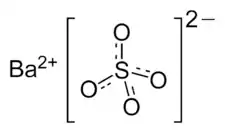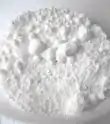Barium sulfate
Barium sulfate (or sulphate) is the inorganic compound with the chemical formula BaSO4. It is a white crystalline solid that is odorless and insoluble in water. It occurs as the mineral barite, which is the main commercial source of barium and materials prepared from it. The white opaque appearance and its high density are exploited in its main applications.[4]
 | |||
| |||
| Identifiers | |||
|---|---|---|---|
3D model (JSmol) |
|||
| ChEBI | |||
| ChEMBL | |||
| ChemSpider | |||
| DrugBank | |||
| ECHA InfoCard | 100.028.896 | ||
| EC Number |
| ||
| KEGG | |||
PubChem CID |
|||
| RTECS number |
| ||
| UNII | |||
| UN number | 1564 | ||
CompTox Dashboard (EPA) |
|||
| |||
| |||
| Properties | |||
| BaSO4 | |||
| Molar mass | 233.38 g/mol | ||
| Appearance | white crystalline | ||
| Odor | odorless | ||
| Density | 4.49 g/cm3 | ||
| Melting point | 1,580 °C (2,880 °F; 1,850 K) | ||
| Boiling point | 1,600 °C (2,910 °F; 1,870 K) (decomposes) | ||
| 0.0002448 g/100 mL (20 °C) 0.000285 g/100 mL (30 °C) | |||
Solubility product (Ksp) |
1.0842 × 10−10 (25 °C) | ||
| Solubility | insoluble in alcohol,[1] soluble in concentrated, hot sulfuric acid | ||
| -71.3·10−6 cm3/mol | |||
Refractive index (nD) |
1.636 (alpha) | ||
| Structure | |||
| orthorhombic | |||
| Thermochemistry | |||
Std molar entropy (S |
132 J·mol−1·K−1[2] | ||
Std enthalpy of formation (ΔfH⦵298) |
−1465 kJ·mol−1[2] | ||
| Pharmacology | |||
| V08BA01 (WHO) | |||
| by mouth, rectal | |||
| Pharmacokinetics: | |||
| negligible by mouth | |||
| rectal | |||
| Legal status |
| ||
| Hazards | |||
| P260, P264, P270, P273, P314, P501 | |||
| NFPA 704 (fire diamond) | |||
| Flash point | noncombustible [3] | ||
| NIOSH (US health exposure limits): | |||
PEL (Permissible) |
TWA 15 mg/m3 (total) TWA 5 mg/m3 (resp)[3] | ||
REL (Recommended) |
TWA 10 mg/m3 (total) TWA 5 mg/m3 (resp)[3] | ||
IDLH (Immediate danger) |
N.D.[3] | ||
Except where otherwise noted, data are given for materials in their standard state (at 25 °C [77 °F], 100 kPa). | |||
| Infobox references | |||
Uses
Drilling fluids
About 80% of the world's barium sulfate production, mostly purified mineral, is consumed as a component of oil well drilling fluid. It increases the density of the fluid,[5] increasing the hydrostatic pressure in the well and reducing the chance of a blowout.
Radiocontrast agent
Barium sulfate in suspension is frequently used medically as a radiocontrast agent for X-ray imaging and other diagnostic procedures. It is most often used in imaging of the GI tract during what is colloquially known as a "barium meal". It is administered orally, or by enema, as a suspension of fine particles in a thick milk-like solution (often with sweetening and flavoring agents added). Although barium is a heavy metal, and its water-soluble compounds are often highly toxic, the low solubility of barium sulfate protects the patient from absorbing harmful amounts of the metal. Barium sulfate is also readily removed from the body, unlike Thorotrast, which it replaced. Due to the relatively high atomic number (Z = 56) of barium, its compounds absorb X-rays more strongly than compounds derived from lighter nuclei.
Pigment
The majority of synthetic barium sulfate is used as a component of white pigment for paints. In oil paint, barium sulfate is almost transparent, and is used as a filler or to modify consistency. One major manufacturer of artists' oil paint sells "permanent white" that contains a mixture of titanium white pigment (TiO2) and barium sulfate. The combination of barium sulfate and zinc sulfide (ZnS) is the inorganic pigment called lithopone. In photography it is used as a coating for certain photographic papers.[5]
Paper brightener
A thin layer of barium sulfate called baryta is first coated on the base surface of most photographic paper to increase the reflectiveness of the image, with the first such paper introduced in 1884 in Germany.[6] The light-sensitive silver halide emulsion is then coated over the baryta layer. The baryta coating limits the penetration of the emulsion into the fibers of the paper and makes the emulsion more even, resulting in more uniform blacks.[7] (Further coatings may then be present for fixing and protection of the image.) More recently, baryta has been used to brighten papers intended for ink-jet printing.[8]
Plastics filler
Barium sulfate is commonly used as a filler for plastics to increase the density of the polymer in vibrational mass damping applications. In polypropylene and polystyrene plastics, it is used as a filler in proportions up to 70%. It has an effect of increasing acid and alkali resistance and opacity. Such composites are also used as X-Ray shielding materials due to their enhanched radiopacity.[9] Composites with high weight percentage (70-80%) of barium sulfate perform better than commonly used steel shields.
Niche uses
Barium sulfate is used in soil testing. Tests for soil pH and other qualities of soil use colored indicators, and small particles (usually clay) from the soil can cloud the test mixture and make it hard to see the color of the indicator. Barium sulfate added to the mixture binds with these particles, making them heavier so they fall to the bottom, leaving a clearer solution.
In colorimetry, barium sulfate is used as a near-perfect diffuser when measuring light sources.
In metal casting, the moulds used are often coated with barium sulfate in order to prevent the molten metal from bonding with the mould.
It is also used in brake linings, anacoustic foams, powder coatings, and root canal filling.
Barium sulfate is an ingredient in the "rubber" pellets used by Chilean police.[10] This together with silica helps the pellet attain a 96.5 shore A hardness.[10]
Catalyst support
Barium sulfate is used as a catalyst support when selectively hydrogenating functional groups that are sensitive to overreduction. With a low surface area, the contact time of the substrate with the catalyst is shorter and thus selectivity is achieved. Palladium on barium sulfate is also used as a catalyst in the Rosenmund reduction.
Pyrotechnics
As barium compounds emit a green light when burned, barium salts are often used in green pyrotechnic formulas, although nitrate and chlorate salts are more common. Barium sulfate is commonly used as a component of "strobe" pyrotechnic compositions.
Copper industry
As barium sulfate has high melting point and is insoluble in water, it is used as a release material in casting of copper anode plates. The anode plates are cast in copper molds, so to avoid the contact of the liquid copper and the solid copper mold, a solution of barium sulfate in water is used as a coating on the mold surface. Thus when the liquid copper solidifies in form of an anode plate it can be easily released from its mold.
Radiometric measurements
Barium sulfate is sometimes used (or else PTFE) to coat the interior of integrating spheres due to the high reflectance of the material and near Lambertian characteristics.
Production
Almost all of the barium consumed commercially is obtained from barite, which is often highly impure. Barite is processed by carbothermal reduction (heating with coke) to give barium sulfide:
- BaSO4 + 4 C → BaS + 4 CO
In contrast to barium sulfate, barium sulfide is soluble in water and readily converted to the oxide, carbonate, and halides. To produce highly pure barium sulfate, the sulfide or chloride is treated with sulfuric acid or sulfate salts:
- BaS + H2SO4 → BaSO4 + H2S
Barium sulfate produced in this way is often called blanc fixe, which is French for "permanent white." Blanc fixe is the form of barium encountered in consumer products, such as paints.[5]
In the laboratory barium sulfate is generated by combining solutions of barium ions and sulfate salts. Because barium sulfate is the least toxic salt of barium due to its insolubility, wastes containing barium salts are sometimes treated with sodium sulfate to immobilize (detoxify) the barium. Barium sulfate is one of the most insoluble salts of sulfate. Its low solubility is exploited in qualitative inorganic analysis as a test for Ba2+ ions as well as for sulfate.
History
Barium sulfate is reduced to barium sulfide by carbon. The accidental discovery of this conversion many centuries ago led to the discovery of the first synthetic phosphor.[4] The sulfide, unlike the sulfate, is water-soluble.
During the early part of the 20th century, during the Japanese colonization period, hokutolite was found to exist naturally in the Beitou hot-springs area near Taipei City, Taiwan. Hokutolite is a radioactive mineral composed mostly of PbSO4 and BaSO4, but also containing traces of uranium, thorium and radium. The Japanese harvested these elements for industrial uses, and also developed dozens of “therapeutic hot-spring baths” in the area.[11]
Safety aspects
Although soluble salts of barium are moderately toxic to humans, barium sulfate is nontoxic due to its insolubility. The most common means of inadvertent barium poisoning arises from the consumption of soluble barium salts mislabeled as BaSO4. In the Celobar incident (Brazil, 2003), nine patients died from improperly prepared radiocontrast agent. In regards to occupational exposures, the Occupational Safety and Health Administration set a permissible exposure limit at 15 mg/m3 while the National Institute for Occupational Safety and Health has a recommended exposure limit at 10 mg/m3. For respiratory exposures, both agencies have set an occupational exposure limit at 5 mg/m3.[12]
See also
References
- CRC Handbook of Chemistry and Physics (85th ed.). CRC Press. 2004. pp. 4–45. ISBN 0-8493-0485-7.
- Zumdahl, Steven S. (2009). Chemical Principles (6th ed.). Houghton Mifflin Company. ISBN 978-0-618-94690-7.
- NIOSH Pocket Guide to Chemical Hazards. "#0047". National Institute for Occupational Safety and Health (NIOSH).
- Holleman, A. F. and Wiberg, E. (2001) Inorganic Chemistry, San Diego, CA : Academic Press, ISBN 0-12-352651-5
- Robert Kresse, Ulrich Baudis, Paul Jäger, H. Hermann Riechers, Heinz Wagner, Jochen Winkler, Hans Uwe Wolf, "Barium and Barium Compounds" in Ullmann's Encyclopedia of Industrial Chemistry, 2007 Wiley-VCH, Weinheim. doi:10.1002/14356007.a03_325.pub2
- The Getty Conservation Institute, Silver Gelatin. The Atlas of Analytical Signatures of Photographic Processes. J. Paul Getty Trust, 2013.
- Salvaggio, Nanette L. Basic Photographic Materials and Processes. Taylor & Francis US, Oct 27, 2008. p. 362.
- Nikitas, Theano. "Inkjet papers that will give your photos pizzazz: are you and your clients bored with your photo prints? check out our favorite fine-art and specialty inkjet papers that are sure to make your images stand out." Photo District News July 2012: 36+. General Reference Center GOLD. Web. 3 Nov. 2012.
- Lopresti, Mattia; Alberto, Gabriele; Cantamessa, Simone; Cantino, Giorgio; Conterosito, Eleonora; Palin, Luca; Milanesio, Marco (28 January 2020). "Light Weight, Easy Formable and Non-Toxic Polymer-Based Composites for Hard X-ray Shielding: A Theoretical and Experimental Study". International Journal of Molecular Sciences. 21 (3): 833. doi:10.3390/ijms21030833. PMC 7037949. PMID 32012889.
- "Investigación U. de Chile comprueba que perdigones usados por Carabineros contienen solo 20 por ciento de goma". Universidad de Chile. November 18, 2019. Retrieved June 29, 2020.
- Chu, Tieh-Chi; Wang, Jeng-Jong (2000). "Radioactive Disequilibrium of Uranium and Thorium Nuclide Series in Hot Spring and River Water from Peitou Hot Spring Basin in Taipei". Journal of Nuclear and Radiochemical Sciences. 1 (1): 5–10. doi:10.14494/jnrs2000.1.5.
- "Barium Sulfate". NIOSH Pocket Guide to Chemical Hazards. Centers for Disease Control and Prevention. April 4, 2011. Retrieved November 18, 2013.


